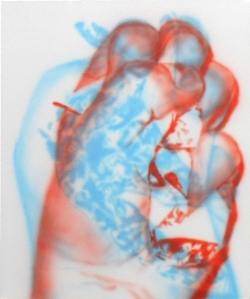
Argentinian artist, Mariano Molina, is well known for paintings that bend perception and has spent the last 5 months with Argentinian neuroscientist (based in the UK) Rodrigo Quian Quiroga, developing a deep intuition about how people perceive art, especially through the use of an eyetracker. Molina says the eye tracker fascinated him because "it was like people were painting with their eyes."
The collaborators are looking for a museum or gallery interested in displaying Molina's art accompanied by explanations of the neuroscience theories the paintings illustrate. They are also applying for a grant that would allow Molina to stay as a resident artist for up to three years. Then, says Quian Quiroga, a paper might be possible. "With science, you have to be very specific and you have to aim to prove just one point," he says. "If you put the word 'art' in the title of the paper, it takes a lot more for people to take it seriously. When you mix art and science, it's not so easy to get published." But Quian Quiroga is not deterred by the bias that exists in his field. He says he has a feeling that the alliance of art and science could open a door to a new way of looking at research.
This link between art and neuroscience is also pursued by my own advisor, Shinsuke Shimojo. I attended his art gallery opening, AFTERIMAGE. This exhibit features founding members Shinsuke Shimojo, Shana Mabari, and Elizabeth Tobias and their collaborative works including installation, photography, video and sounds recordings that explore the relationship between perception, consciousness and neuroscience.

Elizabeth Tobias: Distempered
These images emerge by fusing and layering fragments of my brain signals into saturated photo panels that evoke the title of the series- distempered. Arising from my contemplation of the delicate and all too fragile balance of the mind, the traces of wave signals spill downward in broad strokes, uncontrolled yet precise, expressing the contrast between worldly and unconscious instincts. Each image was blended purposefully rendering raw thought pulsations into inimitable objects. Voltage frequencies and electrical currents are intrinsically vibrant and here they are employed within the larger context of perceptual psychology and neuroscience. The prints simultaneously engage the viewer in observing color fields while exposing my mind engaged in the same activity, creating a visual feedback loop between the audience and myself. Moreover, viewing the images for a sustained period of time modifies photoreceptors, which can induce an afterimage effect.
Dr Shinsuke Shimojo:My Own Loop
A composite of my portrait overlaying several decades of my research logs serves as a backdrop to an experimental installation introducing a Motion Induced Blindness effect. This effect indicates the brain’s sensitivity to moving/changing stimulus and quick habituation to static signals. Scrolling on top of my static portrait are brain waves (Visual and Auditory Evoked Potentials, technically speaking), recorded from my brain. The data appears to be patterns of random waves, but, in actuality, is a collective outcome of electric activity of millions of neurons, from which mental events can be decoded. Viewers are invited to fixate their gaze anywhere on the image for a sustained period to experience a rare visual event. Commonly, brain activity is responsible for perception, but here it is conversely used to suppress it. This contemplative loop also visualizes my internal process as a cognitive neuroscientist- I raise questions about the brain and use my own mind to answer. I am driven by my obsession with psychophysics, visual science, cognitive neuroscience, and sensory development. My education, research and creative inspiration is inextricably linked to my long relationship with experimental psychology within the academic and public arena. Though my projects vary, both my research and art endeavors are unanimously designed to bring to light hidden links. What I find most intriguing about (human) perceptual experience is that what is visible is the result of a hidden, invisible process utilizing physical and physiological optics, subconscious and physiological mechanisms, associations to memory, emotion and action, just to name a few. Thus in short, the brain “knows” much more than what you “see,” and as a result, you see much more than what the retina is able to process. By the same token, perception sometimes goes against conscious expectation. For this project, my long-time collaborator, artist and designer, Shana Mabari, and I created installation pieces that enable viewers to have direct experiences with perceptual effects that have driven me to scientific exploration. Though subjective responses to the work will vary, viewers, as a group, will collectively experience rare optical phenomena, which frames this project in the larger context of critical mass.
Shana Mabari:Proof (with afterimages)
Art is the interpretation of objects projected through the retina to our external reality; psychophysics is the interpretationof objects projected through the retina to our internal reality. I attempt to create one continuous interpretation in my work. Both ‘My Own Loop’ and 'Proof' are experiments within themselves exploring the relationship between creator, viewer, visual effect and experience. They are personal and universal at the same time and can only exist through an observer’s experience. My work with Dr Shinsuke Shimojo has repeatedly pushed the known boundaries of collaborative works merging creative and research fields still in development. I desire to understand our perceptual experiences by devouring the challenges shared by both the art and psychophysics communities.
Proof was my favorite. You place your face against cushioned 'goggles' and dark adapt while fixating a dimly lit central led for 30 seconds, at which point a very strong strobe is flashed through a mask with a cutout shape (snowflake like). This completely saturates your photoreceptors and you perceive an evolving, multi-colored snowflake afterimage overlaying your vision for a rather extended period of time (5-10min).
0 comments:
Post a Comment